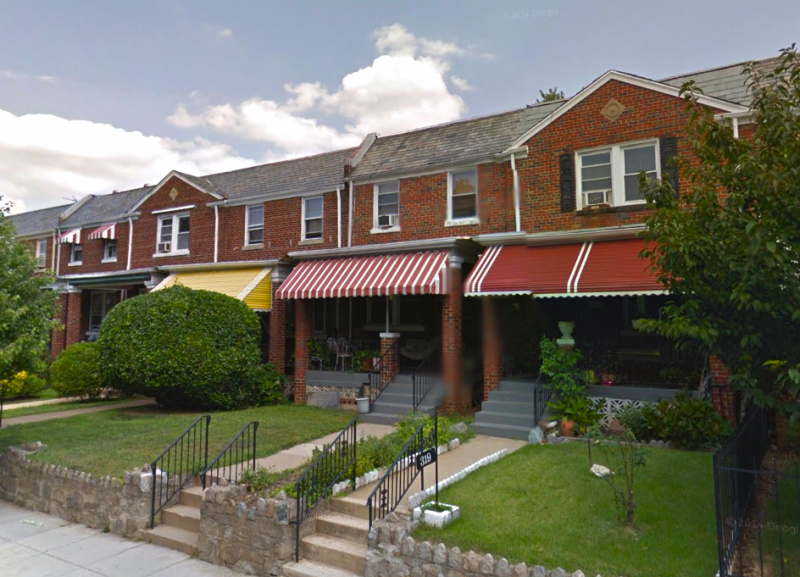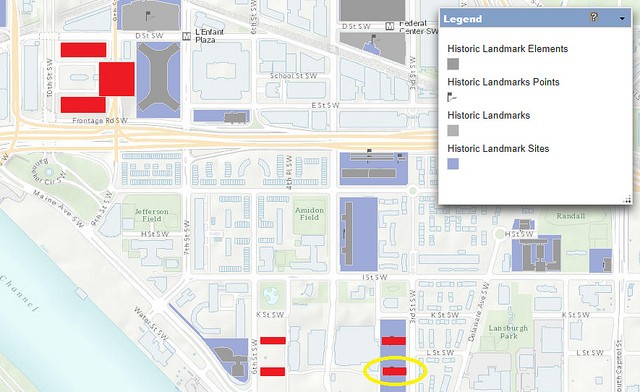Historic preservation in DC prioritizes the loudest neighbors, not the finest buildings

Rowhouses within a proposed Kingman Park historic district. Thousands of 1920s and 1930s rowhouses in DC already have historic protection, and the proposed district would add hundreds more. Image by Google Street View used with permission.
DC has many more historically protected buildings than cities several times our size. This surfeit of historic structures results from several factors, notably the broad application of rather vague criteria for designation. As Roger Lewis has written, “the HPRB decision is inevitably a judgment call because much of the evidence for historic designation is inherently subjective.”
Once acquired, historic designation requires even simple renovation plans to clear numerous additional hurdles, incurring additional reviews, hearings, and redesigns that can cost many thousands of dollars, and possibly resulting in outright denial. The delays, uncertainty, and subjective judgments intrinsic to this process makes it the perfect legal cover for busybodies attempting to keep the status quo permanently so.
The biggest weapon in the arsenal
These squeaky wheels turn to historic preservation because it’s the most powerful regulatory tool in a municipality's land-use arsenal. Zoning is strictly limited to regulating broad aspects of a building like its size, shape, and use. As the Supreme Court described in Nectow vs. Cambridge, “zoning… cannot be imposed if it does not bear a substantial relation to the public health, safety, morals, or general welfare.” No one can reasonably say that public morals are jeopardized when the neighbors paint their window shutters hot pink.
That often leaves preservation laws as the only legal remedy a city has to shape a building's appearance. Preservation is only meant to apply in limited circumstances, to buildings of “a special character or special historical or aesthetic interest or value” (as the Penn Central case, which established the constitutional validity of local preservation designations, says). Once it’s in force, preservation concerns get the final say over just about everything else that might be on a community’s wish list, whether it’s sustainability, affordability, or occupant comfort.
A rush to judgment
Since every resident “squeaky wheel” is invited to request historic designation for just about any site in the District, many do — and overwhelmingly, they succeed. A map of DC's historic designations (many of which are historic districts) shows how they're concentrated in DC's most economically privileged areas. While few buildings in Wards 3, 4, 5, 7, and 8 predate the 20th century, Ward 3 has considerably more historically designated structures than its counterparts.
Base map generated from AtlasPlus. Image by the author.
Historic designation applications closely follow development pressures, as Joe Cortright points out: “if other neighborhoods in the city are designated as ‘historic’ and yours isn’t, then you’re more likely to bear the brunt of development pressures. What makes sense from the standpoint of an individual neighborhood quickly leads to a situation that’s bad for a city.”
This rush by loud neighbors to stave off development through historic protections have resulted in numerous unremarkable buildings finding their way onto DC’s historic inventory. One infamous case involves a strip mall parking lot in Spring Valley — not the only local historic strip-mall parking lot, even though that very idea is considered laughable elsewhere. Its structures were deemed worthy of preservation because, as the nomination form points out, they “are unique in the District of Columbia. Developed by one firm and designed or inspired by one architectural vision, the buildings comprise a cluster that reflects national trends in architecture, merchandising, planning, and retail expansion.” In short, it deserves preservation because it's a strip mall, and strip malls are rare within the boundaries of DC — never mind that they're hardly endangered in Maryland, just three blocks away.
Buildings with blue backgrounds have been designated as historic. Buildings in red were designed by I.M. Pei's firm. The one circled in yellow is a condominium. Base map generated from AtlasPlus. Image by the author.
Across town, I.M. Pei's architecture firm designed seven Brutalist high-rises for developer William Zeckendorf in Southwest Washington: three at L'Enfant Plaza and four at Waterside Mall. Two of them are on the National Register — not the best, not the largest, not the least-altered, not the one Pei most directly shaped, not the one most indicative of his style. Instead, the “historic” ones include one building that happened to be gut-rehabbed and converted to condos, and its condo board was upset by a proposal to build on an adjacent parking lot.
Still not special enough? A district often has lower standards
The arbitrary nature of historic designations was made abundantly clear by DC’s historic preservation staff in a rare 2015 recommendation to deny a historic landmark application for a house in Petworth. In it, they said that the house itself wasn’t that special. Yet, if pulled together with its equally unremarkable neighbors, they cumulatively would clear the bar for architectural significance: “[T]he Board has denied applications to designate [eight addresses] on the grounds that, as architecture, they were not important enough examples or of special distinction in their neighborhoods. An architectural landmark must be a particularly noteworthy example and must be significant to the District of Columbia… The house at 16 Grant Circle does not alone stand out in this way… while not eligible for listing as an Historic Landmark, the house at 16 Grant Circle would undeniably contribute to a Grant Circle Historic District.” Sure enough, just months later the HPRB created the Grant Circle Historic District, evidently at the behest of some residents who wanted to stop construction of legal pop-ups.
Anywhere a penny-pinching developer stamps out identikit designs, the resulting buildings will all look unremarkable, all together — but as long as that togetherness was a while ago, it's apparently sufficient to warrant historic protection. Never mind that the individual buildings might be middling, that their architectural unity is compromised by “non-contributing” buildings in the middle, or that there might be better examples somewhere else.
Other cities take a proactive approach to preservation planning
Many other places, including Arlington, Chicago, and Los Angeles, have proactively done comprehensive “historic resources surveys,” a process that a National Park Service handbook calls the “basis for preservation planning.” The National Historic Preservation Act even lists the first responsibility of a State Historic Preservation Officer, a role that the Office of Planning plays in DC, as “direct and conduct a comprehensive statewide survey of historic property and maintain inventories of the property.”
In these surveys, planners go out into the field to visit and inventory every single building, and evaluate whether it could potentially meet the predetermined criteria for historic designation because of its age, architectural merit, or context. A comprehensive survey is the first step in a proactive approach to preservation that identifies and saves those buildings of greatest historic value — whether the oldest structures, the most noteworthy and influential designs, the best-kept examples of various types and styles, or places that shaped important individuals, events, or movements.
A survey could identify the best examples of particular building types, like those from a certain era, style, architect, or use, and make preservation of the most notable structures a high priority. By doing so, it would guarantee that the stories that those types tell are being preserved, rather than rescuing everything for all time.
The Jost-Kuhn House on Madison St. NW was built as a farmstead before the Civil War, and is decades older than many houses now being considered for historic designation. It did not become a landmark until after an OP survey of farmhouses. Image by Google Street View.
However, OP doesn't seem very interested in a comprehensive survey. It has completed many smaller surveys covering neighborhoods and themes, but even its current preservation plan still sees completing a comprehensive citywide survey as a distant goal for some far-off future year. Instead, it advances still more smaller thematic surveys, e.g., of Georgetown alleys, downtown Modernism, and old farmhouses. The most recent attempt at a District-wide inventory was done by the Joint Committee on Landmarks in the 1960s.
Relying instead on a reactive approach to preservation does an injustice to legitimately interesting buildings whose histories have yet to be uncovered, while also bloating the historic inventory with many other buildings of middling merit. A survey-based approach could not only save more hidden treasures — it probably would have resulted in fewer but higher-quality designations. Chicago's historic resources survey found only 17,371 properties citywide that were even potentially eligible for designation as historic, or just two percent of its structures.
Are we collecting, or hoarding?
Randy Frost, a psychologist who studies hoarding, makes this distinction: “When a collector expands acquisitions beyond well-defined collections… it becomes a hoarding problem.”
Institutions that take their collections seriously have well-defined rules for what enters their collections, because of what philosopher G. K. Chesterton called “the eternal revolution”: “If you leave a white post alone it will soon be a black post. If you particularly want it to be white you must be always painting it again; that is, you must be always having a revolution.”
The Corcoran had a magnificent collection of art, but not all of it was deemed appropriate for the NGA's collection. Image licensed under Creative Commons.
The National Gallery of Art was recently offered the contents of the Corcoran museum, but only took half the pieces. As Peggy Loar, the Corcoran's interim president, told the Post: “If they [NGA] take it in, they have it forever — so they have a big fiduciary responsibility to the United States taxpayer.”
Historic building designation also creates a big fiduciary responsibility: it burdens all future generations of residents with the job of maintaining a building forever, even after its original use and structure have become obsolete.
Preservation costs nothing today, but a lot tomorrow
Maintaining past generations' memories also carries another price: by making urban land more scarce and more expensive, it can hurt future generations' ability to build their own places and create their own memories.
The Obama White House's “Housing Development Toolkit” specifically called out “arbitrary or antiquated preservation regulations” among local policies that discourage new housing development — an “accumulation of even well-intentioned land-use policies [that] can restrict housing availability; create uncertainty for developers and limit private investment; exacerbate the imbalance between jobs and housing; and induce urban sprawl.” (At the time, DC’s planning director dismissed the report, saying they’ve implemented most of its suggestions.)
In New York, preservation and development groups recently issued conflicting reports about whether historic preservation stifles economic growth and housing affordability. The debate has led to some changes in how long landmark designation can take.
If DC wants historic preservation to remain a useful tool for broader planning, rather than one that takes over the entire planning system, it should become more discerning about what it adds to its collection of historic buildings.
